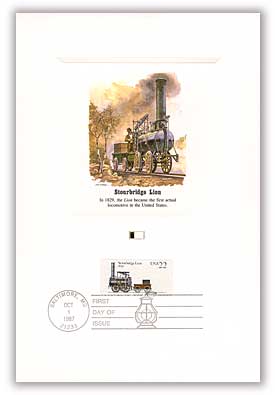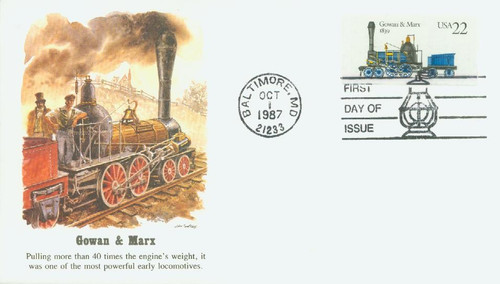
# 2362 FDC - 1987 22c Steam Locomotives: Stourbridge Lion
22¢ Stourbridge Lion
Locomotives
City: Baltimore, MD
Quantity: 78,955,200
Printed By: Bureau of Engraving and Printing
Printing Method: Lithographed and engraved
Perforations: 10 horizontally
Color: Multicolored
The First Steam Locomotive In The U.S.
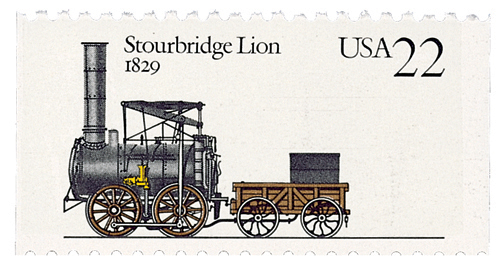
On August 8, 1829, the Stourbridge Lion became the first steam locomotive to be operated in the United States.
The locomotive had been built for the Delaware and Hudson Canal Company (D&H). The company had been founded in 1823 to construct canals between the coalfields near Carbondale, Pennsylvania, and New York City. In 1825, the project’s engineers began to consider using trains to transport the coal to the canal.
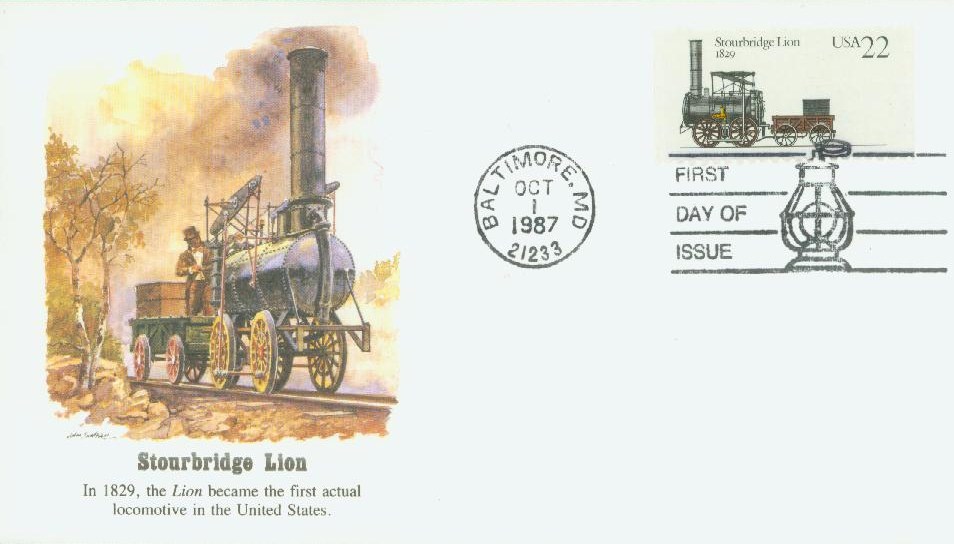
D&H hired John B. Jervis to serve as their engineer. Jervis later designed the 4-2-0 or Jervis type locomotive. He planned the new line as a gravity railroad, in which the trains would travel along an incline, allowing gravity to move the cars. While this system was little known in the US, it was used in Europe. So D&H sent Deputy Engineer Horatio Allen to England to research trains that could be used in this system.

In England, Allen met with the Stephenson family and purchased one locomotive from them. He then met with John Rastrick in the town of Stourbridge and was so impressed by his work, ordered three of his locomotives. One of those locomotives was the Stourbridge Lion, named after the town where it was built and the lion’s head painted on the front. Weighing over seven tons, it cost $2,915.
After being built, the Stourbridge Lion was dismantled and shipped to America, where it was reassembled at the West Point Foundry in New York. There, it underwent initial steam tests and reportedly “became the object of curiosity to thousands who visited the works from day to day to see the “critter” go through the motions.”
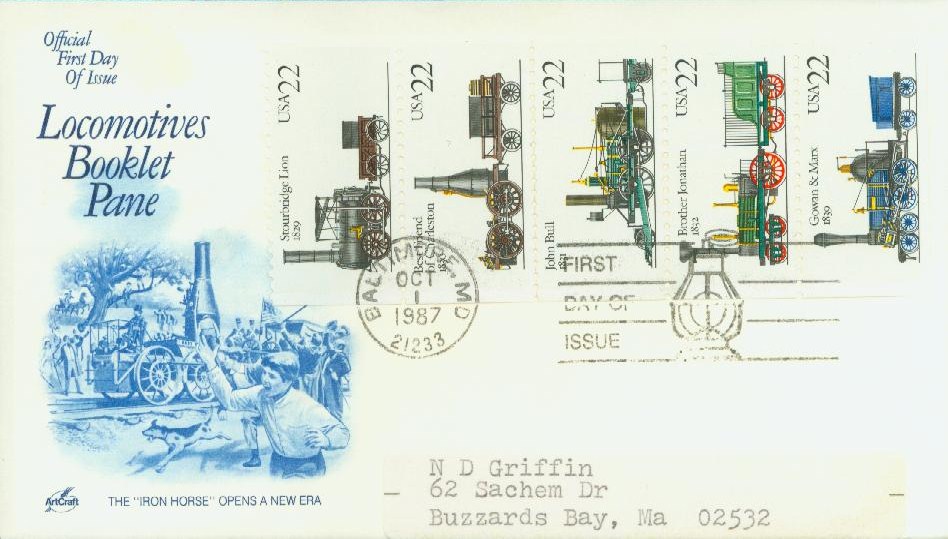
The Stourbridge Lion was then transported to Honesdale, Pennsylvania, for a test run on August 8, 1829. On that day, a large crowd gathered to watch the first steam locomotive operate in the US. Most expected it wouldn’t work – laughing and mocking the locomotive. Many also believed it might kill anyone on board, so Horatio Allen took the test run alone. According to one onlooker, “the fire was kindled and steam raised, and, under the management of Horatio Allen, the ‘wonderful machine’ was found capable of moving, to the great joy of the crowd of excited spectators.”
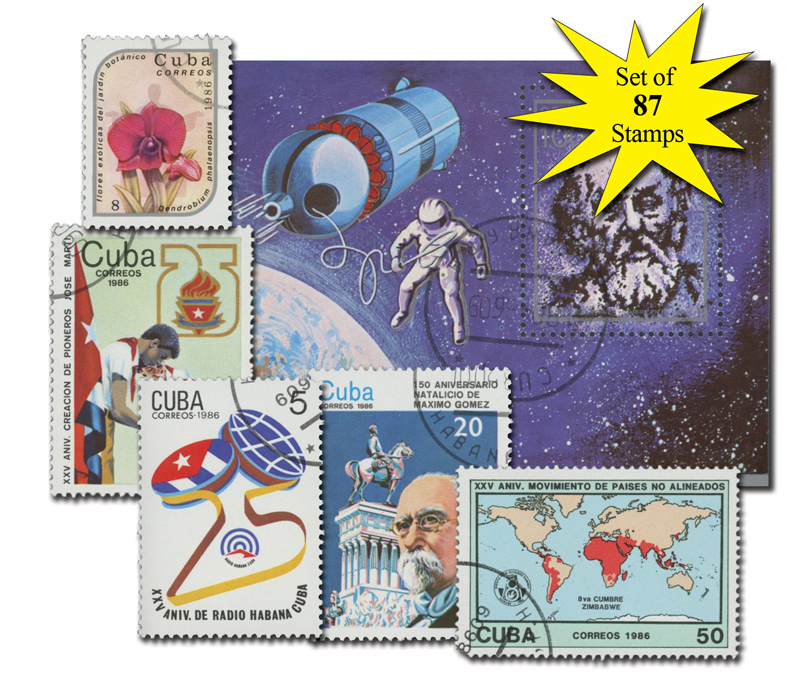
The Stourbridge Lion performed well. Allen drove it about three miles along the track and then returned it to its starting point. However, the company had built tracks that were mostly wood, despite Jervis’ specifications that they be all iron. Also, the train weighed almost double what he had said it should. After a second trial run, it was determined the locomotive was too heavy for use on these rails and was put in storage.
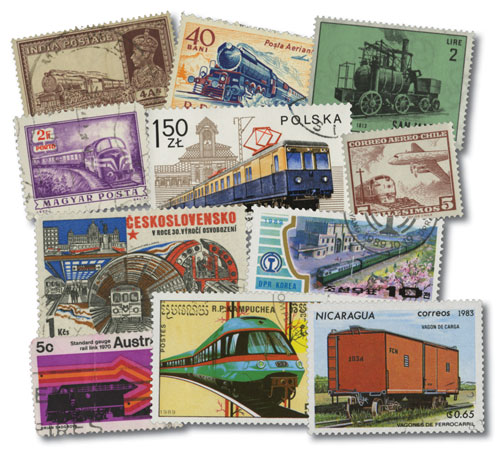
D&H later tried to sell the Stourbridge Lion, though the deal didn’t happen. Over the years, many parts were removed from the locomotive. By 1845, all that remained was the boiler. It was displayed at the Exposition of Railway Appliances in 1883, where thieves in search of souvenirs removed parts with hammers and chisels. In 1890, it was sold to the Smithsonian. The museum attempted to collect the missing parts to rebuild the engine, but was unable to find them all. They then loaned the locomotive to the B&O Railroad Museum in Baltimore.
22¢ Stourbridge Lion
Locomotives
City: Baltimore, MD
Quantity: 78,955,200
Printed By: Bureau of Engraving and Printing
Printing Method: Lithographed and engraved
Perforations: 10 horizontally
Color: Multicolored
The First Steam Locomotive In The U.S.

On August 8, 1829, the Stourbridge Lion became the first steam locomotive to be operated in the United States.
The locomotive had been built for the Delaware and Hudson Canal Company (D&H). The company had been founded in 1823 to construct canals between the coalfields near Carbondale, Pennsylvania, and New York City. In 1825, the project’s engineers began to consider using trains to transport the coal to the canal.

D&H hired John B. Jervis to serve as their engineer. Jervis later designed the 4-2-0 or Jervis type locomotive. He planned the new line as a gravity railroad, in which the trains would travel along an incline, allowing gravity to move the cars. While this system was little known in the US, it was used in Europe. So D&H sent Deputy Engineer Horatio Allen to England to research trains that could be used in this system.

In England, Allen met with the Stephenson family and purchased one locomotive from them. He then met with John Rastrick in the town of Stourbridge and was so impressed by his work, ordered three of his locomotives. One of those locomotives was the Stourbridge Lion, named after the town where it was built and the lion’s head painted on the front. Weighing over seven tons, it cost $2,915.
After being built, the Stourbridge Lion was dismantled and shipped to America, where it was reassembled at the West Point Foundry in New York. There, it underwent initial steam tests and reportedly “became the object of curiosity to thousands who visited the works from day to day to see the “critter” go through the motions.”

The Stourbridge Lion was then transported to Honesdale, Pennsylvania, for a test run on August 8, 1829. On that day, a large crowd gathered to watch the first steam locomotive operate in the US. Most expected it wouldn’t work – laughing and mocking the locomotive. Many also believed it might kill anyone on board, so Horatio Allen took the test run alone. According to one onlooker, “the fire was kindled and steam raised, and, under the management of Horatio Allen, the ‘wonderful machine’ was found capable of moving, to the great joy of the crowd of excited spectators.”

The Stourbridge Lion performed well. Allen drove it about three miles along the track and then returned it to its starting point. However, the company had built tracks that were mostly wood, despite Jervis’ specifications that they be all iron. Also, the train weighed almost double what he had said it should. After a second trial run, it was determined the locomotive was too heavy for use on these rails and was put in storage.

D&H later tried to sell the Stourbridge Lion, though the deal didn’t happen. Over the years, many parts were removed from the locomotive. By 1845, all that remained was the boiler. It was displayed at the Exposition of Railway Appliances in 1883, where thieves in search of souvenirs removed parts with hammers and chisels. In 1890, it was sold to the Smithsonian. The museum attempted to collect the missing parts to rebuild the engine, but was unable to find them all. They then loaned the locomotive to the B&O Railroad Museum in Baltimore.






